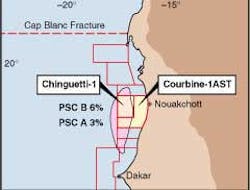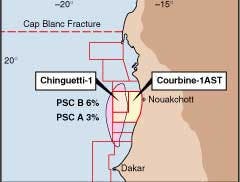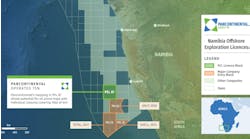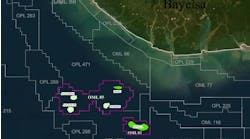Woodside's Chinguetti discovery off Mauritania last year may trigger a bout of deepwater drilling off North West Africa. Representatives from the oil companies concerned (mainly Australian) outlined their view of progress to date at IBC's West & Central Africa oil and gas conference in London last fall.
The Chinguetti-1 well was drilled in 800 meters of water by the semisub Scarabeo-7 in Mauritania offshore block 4, with costs shared by Woodside as operator and its partner Agip. The well was completed as an oil and gas find last May, having reached a depth of 2,620 meters. The well intersected several oil-bearing sandstones in the primary Tertiary target area over a 120-meter gross hydrocarbon column, without encountering an oil-water contact. A shallower, secondary objective revealed gas-bearing sandstones over a 7-meter interval.
Four oil samples were recovered from the primary objective sandstones using a wireline sampling tool. The discovery proved for the first time the existence of a fully functioning petroleum system in the Mauritanian deepwater basin. Woodside and its partners added that other prospects had been identified within a 20 km radius of Chinguetti-1.
Subsequently, another exploratory well Courbine-1A, was drilled 20 km to the northwest to a depth of 4,450 meters, and completed last July as a sub-commercial gas discovery. Scott Spencer of Hardman Resources, a partner in this program, said at the conference that Woodside still does not understand why hydrocarbons weren't present. Courbine, like Chinguetti, is a salt structure, and had pre-drill reserves estimated at 220 million bbl.
The main reservoir objective - an Upper Cretaceous interval between 3,800 meters and 4,000 meters - was deemed to be water bearing, with minor hydrocarbon shows. Tertiary sandstones comprising a secondary reservoir above 3,185 meters were shown to hold a 9-meter gas column. However, at least the well demonstrated that key elements of the petroleum system are in place.
This year, up to two appraisal wells are being lined up on the Chinguetti structure to determine the extent and quality of the oil, and up to two exploration wells also are planned nearby. This would likely be followed by two to three exploration wells in 2003 on other prospects. The brightest of these leads appear to be in Miocene sands.
Current evaluation by the partners suggests that Chinguetti-1 has the potential to be a stand-alone commercial development, the threshold being around 100 million bbl. Pre-drill reserve estimates of 180 million bbl still seem reasonable, but require confirmation from appraisal drilling. It could also serve as a hub for future, smaller discoveries nearby. Results from Courbine have downgraded or extinguished certain leads in this part of the permit, but not all the Cretaceous plays are so affected.
Seismic leads
Mauritania has a population of 2.6 million, and no indigenous oil production - although it does possess a functioning refinery. According to Lalle Mariem Mint Moulaye, the Deputy Minister for Industry & Mines, the country has two basins with known hydrocarbon potential covering an area 160,000 sq km on and offshore.
Woodside operates offshore blocks 2-6, in partnership with Perth-based companies Hardman Resources and Fusion Oil & Gas, and Elixir. Dana Petroleum operates offshore blocks 1, 7, and 8, in tandem with Hardman and Elixir. Both parties have swelled Mauritania's seismic inventory, with Woodside acquiring 10,450-line km of 2D seismic in 1998 and 3,500 sq km of 3D seismic. Dana has completed a new 2D survey over Block 7 and is also considering a 3D acquisition program. In addition, Veritas recently conducted a spec survey over the ultra-deep offshore, Moulaye said.
Mauritanian offshore PSCs B and A, where both of last year's deepwater wells were drilled by a consortium led by Woodside Energy.
Woodside Energy's International Exploration Manager, Peter Grant, said his company had initially acquired 2D seismic to formulate the key play components. Prior drillbit experience had been a small oil discovery by Shell on Block 6 in 1974. Because of the large extent of the acreage awarded in the late 1990s (40,000 sq km in blocks 2-6), Woodside and its partners decided to move briskly to 3D seismic acquisition, followed by drilling of two prospects.
"We wanted to determine and evaluate two different play types in the basin," Grant claimed. "Courbine lay much deeper within the Cretaceous. It proved difficult to penetrate three different targets with one wellbore on Chinguetti, but we believe this has the makings of a new deepwater province. We found a 90-meter oil column within the Tertiary. The oil-bearing interval was as predicted, with deepwater turbidite channel sands structured by a salt diapir. The 28.7
"Courbine proved onerous to drill, with a lot of pressure - in fact, it was one of the most difficult wells Woodside has drilled anywhere. Unfortunately, hydrocarbons were found only in the upper parts of the well. But it does appear that the Mauritanian offshore basin is a working hydrocarbons system generating a significant volume of oil.
"We're now studying results in preparation for future exploration and appraisal wells in the Greater Chinguetti area. The Mauritanian authorities are more than willing to mitigate the technical risk involved, through program deferrals and so on. Like us, they don't want dry wells. But it should be pointed out that we've had a 50% success rate in a virgin basin. Now we must effectively explore our vast acreage tract before the Area B PSC [deepwater block 5] re-negotiation comes up next year."
For mid-size oil companies, the drilling costs can be prohibitive in this remote location. "Nigeria and the North Sea have the nearest bases, so that's a minimum distance of 5,000 km away. Another problem is that the capital, Nouakchott, is very dry. We had to bring in a ship with fresh water for the wells - the amount was equivalent to one month's supply for the whole town," Grant said.
North of the offshore permits is a national park, the Banc d'Arguin, a World Wildlife Fund-supported breeding ground for migratory birds to and from Europe. This is also a fertile fishing and seal breeding area. "We have avoided drilling at times of the year when the current would take materials into the park," Grant said.
"We're committed to delivering first prod-uction to Mauritania, but the two wells we have drilled cost $60 million - partly due to the remoteness of the infrastructure. To offset this in future, we need lower cost, smart wells. We hope to bring about production in the same time frame that Triton Energy managed off Equatorial Guinea - that's a tough time frame."
Alan Stein, Fusion's Managing Director, commented that one of the primary risks with exploration in this area is the presence of large piles of sand deposited offshore. "However, our wells to date have confirmed our ability to map the sand-rich fairways, which gives us confidence to go forward. The fidelity of 3D seismic is important in this region. Direct hydrocarbon indicators (DHIs) ellipse can indicate stacked hydrocarbon-bearing reservoirs above salt diapirs. As we drill more, we will get a better idea of how reliable these DHIs are."




